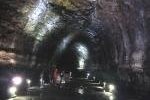
Another day, another island on our RTW cruise – but this visit to Jeju was more critical than most as it offered the promise of a completely new WHS after a long period of “revisits” since Rapa Nui on the other side of the Pacific! With just 9 hours ashore we somewhat reluctantly decided to use a standard tour which promised to take in 2 of the 3 elements of the inscribed site, together some more of Jeju’s delights!
The big worry was whether the tour would give us enough time at our priority sites and after visits to a crater, a folk village and a resort it was after lunch before we reached the Seongsan Ilchulbong tuff cone, otherwise known as “Sunrise Peak” (Our lunch by the way was served in the visually stunning “Glass House” by Tadeo Ando – well above the normal quality of restaurant used for tourist groups around the World but it was a pity we couldn’t also take in his “Genius Loci” or the interior of Botta’s “Agora” at the same Phoenix Island location!). We were then presented with an option – either go to see the Haenyeo diving ladies whose “show” commenced at 1.30 or climb to the top of the crater – in either case we would leave in 1 hour and it was now 1.05!!
Well there was no alternative of course but to try for both - and it was well worth doing so too. Seongsan Ilchulbong is often described as a huge offshore stone castle with sheer cliffs all round – in reality it is connected to “mainland” Jeju by a spit of land but the climb starts only a bit above sea level and climbs steeply to the summit at 182 metrs. It was a popular spot and the stairway got very crowded. The summit revealed that those steep sides hid a deep circular crater (its floor just 90 metres above sea level) - this is a “volcanic cone formed by Surtseyan-type hydrovolcanic activity about 5,000 years ago” (Wiki). The views on all sides were spectacular from the very narrow summit ledge.
Next to the diving ladies so, after a speedy climb of 15 minutes, it was less half than that to run down. Luckily they started a bit late and we arrived in time to see and hear the rituals they undertake before diving. The Haenyeo are mainly old ladies who dive without oxygen down to 20 metres for conch, urchin, abalone and octopus looking a bit like “Michelin men” with their rubber wet suits highlighting their avoirdupois! Apparently they are embarked on a project to be inscribed as “Intangible Cultural Heritage” – it was certainly an interesting vignette of Korean culture and worth taking in if you can, even if the show at Sunrise Peak is one put on for tourists
So, it was on to the “main event” – the Geomunoreum lava tube system “regarded as the finest lava tube system of caves anywhere,” (UNESCO – though Hawaii et al might disagree!). Arrival at 2.40 gave us a full hour to cover the underground walk with reasonable time to take in the atmosphere and the numerous geological phenomena on display. Only 1 km of one of the tubes, that of Manjaggul, is open. Its entire length is 13.4kms with a height of 23m and a width of 18m (photo). We had visited lava tubes in USA but found Manjaggul a worthwhile experience, well presented with informative signs.
Both Seongsan Ilchubong and Manjaggul deserve a bit of research before and after a visit to help understand the geological processes which created them and what makes them special enough to be inscribed. Ok, Jeju requires more than the 9 hours we gave it, but I felt we used our limited time reasonably well and, in particular, that we did justice to the 2 WHS elements we visited (and we saw the third as we sailed away with the sun shining brightly on the snow capped peak of Mt Halla!).
More on
Comments
No comments yet.
